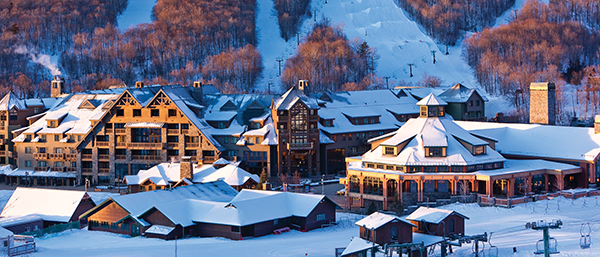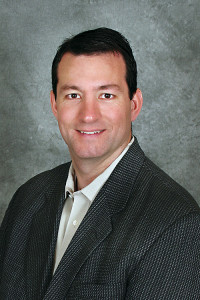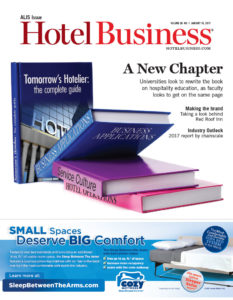ENGLEWOOD, CO—For the past five years, Destination Hotels, based here and now part of Two Roads Hospitality, has polled corporate, association, government and independent meeting planners to examine the latest trends affecting the planning and executing of their events. The results of the recently released fifth-annual “State of the Meetings Industry” survey were culled from the responses of 405 meeting planners (23,819 were contacted to participate) who were asked about how their planning duties and their meetings are changing for this year.
The survey is an important tool that allows properties in the collection of luxury and upscale independent hotels, resorts and residences across the U.S. to fine-tune their offerings in order to meet the needs of their meetings clients.
“It allowed us to take a temperature check with our customers to make sure our properties are providing the services needed,” said Kevin Barosso, VP of global group sales for Two Roads Hospitality. “It’s kind of twofold. For the planner: What’s happening in your world? What are you experiencing? What can we expect as a supplier of meetings? And, it’s also an opportunity for us to understand if our hotels and resorts are supplying what the planner is looking for.”
Perhaps the most significant finding in this year’s survey, according to Barosso, is that room rate ranked nearly just as high as the most important consideration when choosing a meeting venue. Location, as in past surveys, ranked first (9.21 on a 10-point scale), but room rate was very close behind (9.20).
“Location has always dominated as the most important aspect as to where to hold a meeting. Not that room rate was not important before, but it was of less significance the previous year,” said Barosso. “I think there are two dynamics at play: The majority of respondents whose budgets are staying the same in terms of what they are allowed to spend per meeting, and the fact that we’ve hit the crossroads where we have rates and demand increasing because there hasn’t been a lot of new supply. Factor in the airlift situation, and the fact that most popular places to have meetings in your highest demand locations are seeing the highest rate increases. That’s putting a lot of pressure on the planners to deliver a high-quality program like they had one or two years ago, maybe even three years ago, on a similar budget, while costs are increasing.”
As far as budgets and frequency of meetings go, the survey found that 37% of respondents will have more money to spend on meetings in 2017, a jump from last year’s figure of 31.5%, and 30% will be planning more meetings this year.
According to the survey, team-building exercises are also important to meeting planners. Nearly 60% of respondents said they are most interested in adventure/active exercises, with another 37% of planners citing community service as a highly desired team-building option.
Barosso noted that some Destination hotels have activities like zip-lining, such as Stowe Mountain Lodge in Stowe, VT, as well as scavenger hunts and rope courses, which are “a little bit active, but not too strenuous.” He stressed the fact that networking is a major factor in any of these activities. “The importance of team-building is related more to networking. We’ve seen companies add a number of virtual offices, or get involved in mergers and acquisitions over the last couple of years. There’s been more of an emphasis on networking-type team-building where there can be some fun. Activities like sushi-making and pasta-making remain popular, since they are social events that create networking opportunities among the attendees that maybe just wouldn’t organically happen on its own.”
The survey also found that nearly 73% of respondents said that flexible-space configurations rated eight, nine or 10 in importance to them when choosing properties for their 2017 events; this is a jump from the 68% of planners who said that for their 2016 events.
While formal meeting spaces and prefunction areas at many Destination properties are being tweaked for added flexibility, one way the brand is assuring meeting planners that they are getting everything they need is by teaming them up with in-house conference planners that have earned the brand’s DEP certification.
“DEP stands for Destination Event Producers. We wanted to come up with a way that we can train our corporate service planners in our different properties on a consistent platform where they are delivering on our brand pillars,” said Barosso. “The program is also an effort to make sure we are recognizing the top conference planners in our company—the ones who are delivering great service and are receiving rave reviews from their customers. So, when customers see that they are working with a conference planner on property that has DEP certification, they know they are working with the best of the best.”
While the overall ranking of the importance of on-site technology offerings this year was 7.48, more than 58% of planners ranked this factor as an eight, nine or 10 in importance to them. But, while state-of-the-art equipment is something every meeting planner and conference attendee would like to use, Barosso said the most important technological offering for meetings is bandwidth.
“Everyone wants the most amount of bandwidth for the least amount of cost,” he said. “We are trying to work with owners to make them understand the cost of entry and the cost of going above and beyond. We all travel with multiple devices, so connectivity is a must. The upgrades to the system and the equipment are very expensive. In a lot of cases, you are talking about six-figure investments. When someone is spending that much money, they are expecting some sort of return on that.”
However, he noted, “There are certain creative ways that we can get around moving bandwidth. If the hotel is set up properly, you can partition off the internet based on where people are on the property. You can direct higher amounts of bandwidth to that area of the hotel. For example, if 80-90% of your occupancy is group based, and from 9-11 a.m. and then 1-5 p.m., everyone is in the conference space, then you know 20% of occupants in your hotel could be in a guestroom or maybe in other public areas, and you can redirect greater amounts of bandwidth where people are. Of course, that means a lot of communication, so that when the meetings are done, the bandwidth can be set back to the original configuration.”
Communicating with guests through their smartphones is also important to Destination Hotels, noted Barosso.“We are demoing a couple of different applications to help us communicate with our guests, so if they need room service or need the temperature changed in a meeting room, they are able to communicate with the hotel staff quickly and seamlessly.” HB



